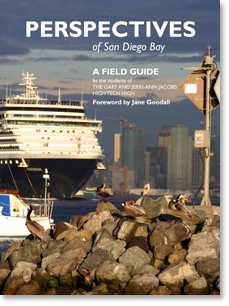A Field Guide
by the students of High Tech High
Foreword by Jane Goodall
 |
|
January 2006 ♦ Paperback ♦ 246 pages, 500 color photographs, charts, and graphs ♦ ISBN: 0-9762706-5-X ♦ $24.95
ORDER Click on the "Buy Now" button below the book cover.
Download (PDF) excerpts from the book.
Holding a meter-square contraption made of white PVC pipes, a few students crouch over a patch of tide-washed sand, counting the limpets and barnacles they find within the transect. Up the shore, classmates are using a laser leveling device and a pole to measure off the tide's height at regular intervals. Others poke around the water's edge, turning over rocks or following the path of a shorebird. A few solitary students sit at a distance with notebooks, writing or drawing in response to the urban seascape before them.
Like the explorers who sailed into this bay 300 years ago, 56 students at High Tech High in San Diego have discovered a new world in their urban neighborhood, where land meets sea-and where schoolwork actually matters.
For three months in spring 2005, an eleventh-grade High Tech High teaching team centered its math, science, and humanities coursework on an ambitious investigative project. In expeditions to sites around the nearby bay, students carried on the tradition of the explorer's log, rendering close observations—scientific, cartographic, etymological, even poetic and political—for others who might follow.
Now those students have brought their work to the public, as a striking and useful field guide called Perspectives of the San Diego Bay. The 240-page book, which they designed and produced themselves, with a small grant from What Kids Can Do and the Bill & Melinda Gates Foundation, already has found an eager audience in local and national environmental groups.
For its authors, that means more than any A on their report cards. "Every kid has that question, 'Where am I going to use this in the real world?'" says Evan Morikawa, one of the guide's chief student editors. "Well, you can't get much more attached to the real world than this. My friends are like, 'I'm studying for finals right now,' and I'm like, 'Well, I'm going to make and publish and print and sell a book!'"
Beautifully illustrated and designed, filled with color photographs, maps, and charts, the field guide teems with life, energy, and detailed information. It stands on its own as a naturalist's guide, identifying, analyzing, and quantifying the life forms found in the bay's intertidal zones and harbors. A student-written history of mapmaking by early explorers segues into a state-of-the-art overview of present-day biogeography, with students using sophisticated GIS mapmaking technology to represent their data. And in the tradition of the adventurer's log, students offer philosophical perspectives on the worlds they observe, in reflections, poems, and commentary pieces.
Not least, these young authors have an explicit public purpose: to awaken San Diego to the potential destruction of its Bay, as the balance grows ever more precarious between their city's natural life, industry, and commerce.
| Early Praise: "The field guide presents a wonderful synthesis of original science, review of published information, and humanistic insights into conservation. If only the rest of America were as interested, informed, and dedicated as your students, this country could readily solve its environmental problems. I do hope that all your students will in the future remain involved in and contribute to conservation." — George B. Schaller, Wildlife Conservation Society, New York "There is hope for nature! Just when you thought younger generations have lost the ability to venture more than ten feet away from their Playstation 2's, the students of High Tech High have produced a field guide that not only gives a three dimensional picture of San Diego Bay, but also inspires with every page..." — Randy Olson, Ph.D., Filmmaker/Marine Biologist, Director of The Shifting Baselines Ocean Media Project "The scientific components are as good as any I've seen, while the poems and personal reflections on nature, science and place help to bring the San Diego Bay area alive. Taken together, they capture the essence of not just a region, but of the deep connections between nature, science and humanity..." — Thomas Hayden, Senior Writer, US News & World Report "The Venn diagram in the early pages says a great deal about the well-organized integration and multidisciplinary nature of this wonderful project. I was also delighted to see evolution given a prominent heading and early introduction. Bravo!" — Oliver A. Ryder, Ph.D., Zoological Society of San Diego and Kleberg Genetics Chair, Conservation and Research for Endangered Species "I am particularly thrilled with their use of cutting-edge Geographic Information Systems (GIS) and Global Positioning Systems (GPS) technology to create biogeographical maps. This practical book employs a cross-disciplinary approach which skillfully combines the humanities with technology." — Dr. Ming-Hsiang Tsou, Associate Professor of Geography, San Diego State University "...I'm going to keep a copy in my office as a reference for my local research and teaching activities and buy many copies as beautifully illustrated gifts for friends' coffee tables!" — Brian T. Hentschel, Assistant Professor of Biology, San Diego State University |


